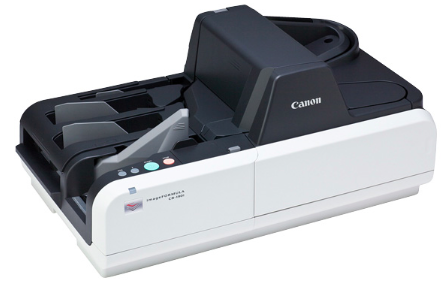Symco Group buys, sells and maintains (on-site, depot and advanced exchange maintenance options) check scanners from all the leading check scanner manufacturers including Canon, Burroughs, Digital Check, Epson, Magtek, Panini and RDM. Symco Group also sells maintenance kits and supplies for all the scanners we sell and support.
If you are looking for one or more check scanners, maintenance kits or supplies please contact Symco Group at 800-878-8002 or email us at info@symcogroup.com.
imageFORMULA CR-190i Check Transport Product Spotlight

Overview:
The Canon imageFORMULA CR-190i High-Volume Check Transport is the cornerstone for production check processing, delivering high performance, reliability, and image quality. With an efficient countertop design, the CR-190i check transport is capable of meeting even the toughest challenges.
The CR-190i check transport can help financial institutions, utilities, and other organizations that handle large volumes of checks improve the efficiency of payment processes and treasury management. This results in faster access to funds, reduced costs, and increased ROI. The features offered by this check transport are ideal for high-volume remittance processing, lockbox, and back-office/branch capture.
Features:
Dynamic Performance:
- Scans up to 190 Checks Per Minute: Capable of maintaining impressive scanning speeds with processing features enabled:
- One-Line CIS CMOS sensor with three-line parallel data transfer
- Two independent motor drive units capable of handling up to three items simultaneously in the paper-path
- M-shaped Paper Path: Makes it possible for the CR-190i check transport to achieve
- Dynamic Sorting – eject pocket sorting based on current item MICR data
- Dynamic Endorsement real-time dynamic four-line endorsement
- High Volume Check Scanning: Advanced features enable high-volume check processing
- 250-item ADF with drop-in ability
- 200-item eject pockets (two)
- 50-item eject pocket (one)
- Eject pocket “waterfalling”
- 24,000 item Suggested Daily Volume
Exceptional Reliability:
- Versatile Scanning: The CR-190i can handle large numbers of checks and other related small documents
- Dependable Document Handling:
- The CR-190i delivers exceptional document handling with:
- Corrugated Retard Rollers
- Ultrasonic Double Feed Detection – To accurately monitor double feeds
- Built-in Jogger – with redesigned rollers, the jogger helps ensure proper document alignment and helps eliminate misfeeds
- Magnetic / Optical Character Recognition: Canon achieves precise MICR data with:
- Optimized MICR algorithm
- MICR data complemented with OCR processing – Utilizes a MICR reader as well as OCR
- The CR-190i delivers exceptional document handling with:
Impressive Image Quality:
- High-Precision Optical Technology: The CR-190i delivers impressive image quality through:
- One-line CMOS CIS sensor – with three-line parallel data transfer
- Fine Text Filtering – Binarization that removes patterned backgrounds and enhances edges around text for sharper images and improved OCR accuracy
- 1200 dpi optical resolution – For fine print and small details
- Up to 300 dpi output resolution – Valuable check information can be precisely reproduced
Efficient Design:
- Countertop Convenience: The CR-190i check transport’s compact, robust and easy access design allows this device to fit into busy environments
- Easy Maintenance:Simple and risk-free operator performed maintenance thanks to:
- Clam-shell paper-path access
- Enclosed mechanics
- “Function Button:” Programmable control panel button for third party application functions by software developer
Specifications:
- Model Name:
- imageFORMULA CR-190i Check Transport
- Type:
- High-Volume Check Transport
- Document Feeding:
- Built-in Automatic Feeder (ADF)
- Document Size:
- Width 2.7 – 4.2
- Document Size:
- Length 4.7 – 9.6
- Thickness Automatic Feeding:
- 0.003 – 0.008 (17 – 40 lb. Bond)
- Bypass mode:
- 0.003 – 0.02 (17 – 112 lb. Bond)
- Feeder Capacity:
- Approx. 250 Sheets
- Grayscale:
- 256-level, 16-level
- Scanning Element:
- Improved One-line Contact Image Sensor (CMOS)
- Light Source:
- RGB LED
- Operating Modes:
- Simplex
- Duplex
- Grayscale
- Black and White
- Fine Text Filtering
- Error Diffusions
- Optical Resolution:
- 1200 dpi
- Output Resolution:
- 100/120/150/200/240/300 dpi
- Scanning Speeds:
- Black And White
- (Simplex / Duplex): 190 cpm/190 cpm
- Grayscale
- (Simplex / Duplex): 190 cpm/190 cpm
- Black And White
- MICR/OCR:
- MICR: E13B / CMC-7
- OCR: E13B / OCR-A/OCR-B / Check Writer / Universal Character
- Interface:
- Hi-Speed USB 2.0
- Scanner Drivers:
- Windows XP / Windows Vista / 7
- Dimensions:
- 8.4 x 18.7 x 10.7
- Weight:
- 18.5 lb.
- Power Consumption:
- 56.1 W or Less (Energy Savings Mode: 3.9 W or Less)
- Suggested Daily Volume:
- 24,000 Scans**
- Other Features:
- Auto Page Size Detection Built-in JoggerColor Dropout MOCR-based
- Imprinting MOCR-based Sorting Deskew Function Button Paper Eject
- Button Three Output Pockets (200 / 200 / 50)
- Continuous Feeding Waterfall Output Mode
- Bundled Software:Silver Bullet Ranger Driver with IQACanon
- Scanning Utility Software
Examples based on typical settings, rated in checks per minute with U.S. personal checks at 200 dpi in black and white or grayscale.
** Calculation based on scanning speed and typical daily time of usage.
